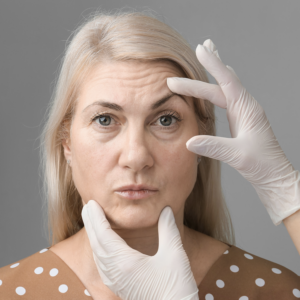Face Forward: Will You Tweak Your Looks As You Get Older?

Face Forward: Will You Tweak Your Looks As You Get Older?
February 7, 2024
If you walk past a mirror, it’s hard to avoid a bit of startle, especially if you have one image of yourself (perhaps based on your look from several decades ago) and yet you see a reflection that more candidly shows what you look like today. Some of us gracefully accept the changes in our faces and even relish the lines and wrinkles we’ve earned. Others take a good hard look at the current state of affairs and wonder, is there something to be done with this face? Could a small or even more significant intervention give me a look I’d be happier with? It’s a very individual choice and, no judgment here, there are many options available for those who want to explore what procedures and possibilities await in the offices of a cosmetic surgeon.
The evidence that many are turning to procedures and even surgery is overwhelming. Take a look at such celebrities as Dolly Parton, Cher, or even Martha Stewart and it’s hard not to make a connection between their current flawless skin and the options available with a scalpel or syringe. As was stated in a recent post in New Beauty, there’s been a growing acceptance of cosmetic treatments and cosmetic surgery and as more of us lead healthier and longer lives, many inevitably want their faces to reflect a sense of vitality and good health. Moreover, the options available for subtle and less risky procedures have grown exponentially, as neurotoxins, fillers, and laser procedures have made cosmetic changes easier, cheaper, and less invasive. Most who seek out these treatments do not desire a vastly different face- just one that has them looking like a more refreshed version of themselves. As one writer stated in an article about her own journey with fillers, “The best tweaks should be undetectable. You just want to look like yourself- but better.” For an explanation of all of the options available for fillers in your face, take off all your makeup and click here. However, even though these procedures are considered “tweaks” and perhaps minor, they are not without some risk, and the quality and integrity of the professional performing the procedure are critical. For an eye into what side effects can occur, take a look here.
Ironically, however, we also live in an age where more invasive surgical procedures- such as facelifts- are achieving better results with fewer risks than were previously available. For a list of current cosmetic surgical procedures performed, click here. Facelifts, in particular, have evolved from previous eras, where the face of those surgically lifted appeared stretched or pulled. Similar to fillers, the goal these days with facelifts is that the work is actually undetectable and that telltale signs of the surgery are invisible. While a facelift still constitutes major surgery, with all of the risks and recovery still in place (you may need 3-6 months to fully recover, and the results seem to last 10-15 years), a newer type of facelift, called a “deep plane” facelift has apparently led to much more natural and better results. For those who have suffered “filler fatigue” or have had other complications from various injections, this new type of facelift might be an alternative, albeit one that’s much more costly.
But as a reminder, the risks of surgery for older adults cannot be dismissed. There are the usual risks of infection, bleeding, scarring, pain, and even nerve damage. And for those with such underlying conditions as diabetes, heart disease, obesity, or high blood pressure, there are also increased risks for undergoing surgery. While there’s no age limit per se as to who can undergo cosmetic surgery, the reality is for older adults, we heal slower, our skin has less elasticity and complications are always a possibility. As with any surgery or medical procedure, it’s a matter of balancing risk and benefit. For some, the benefit of a refreshed and youthful face is worth whatever risks come along. For others, as Kahlil Gibran once said, “Beauty is not in the face; beauty is a light in the heart.” Bottom line? It’s an individual choice- just make sure it’s an informed choice.







